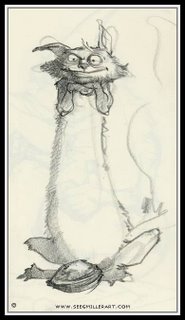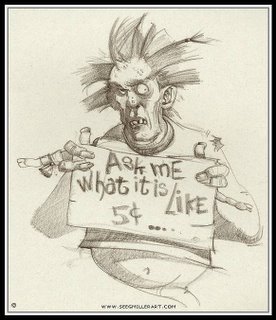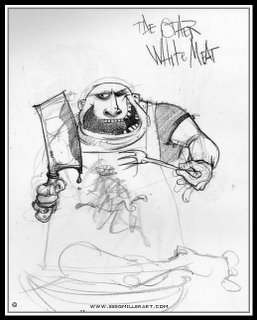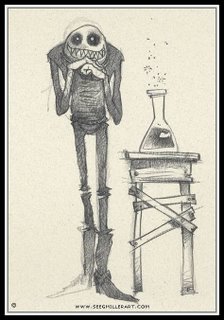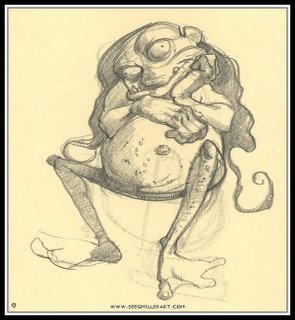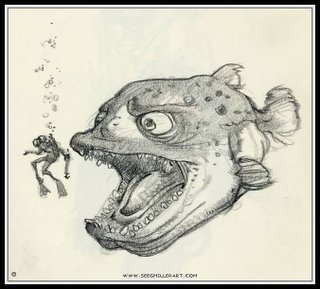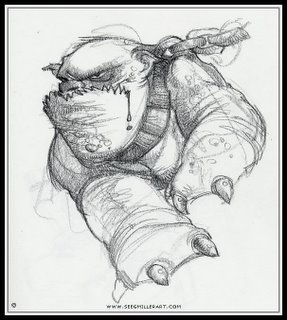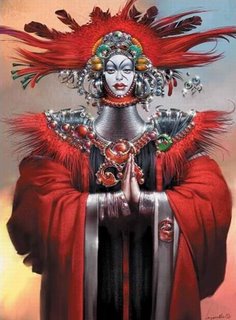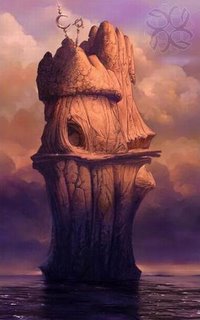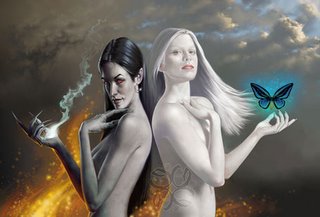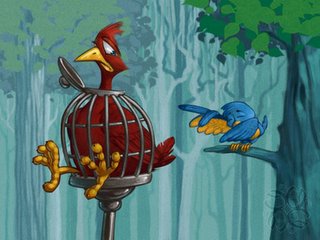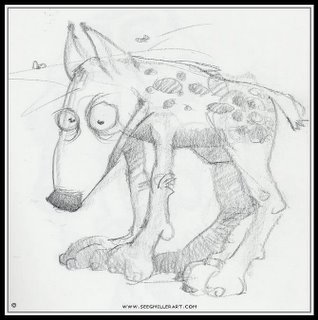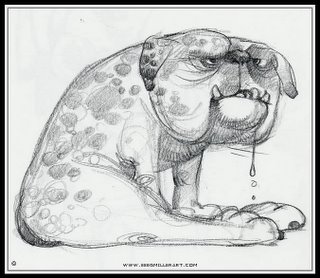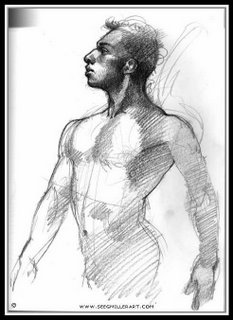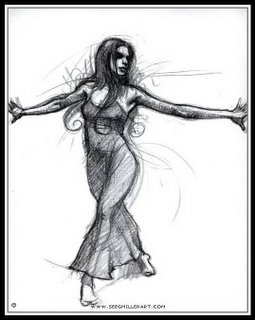DON SEEGMILLER INTERVIEW
Illustrator
Friday, January 27, 2006
BROUGHT TO YOU BY THE CHARACTER DESIGN BLOGSPOT
IF YOU WOULD LIKE TO SEE MORE CHARACTER DESIGNERS GO TO THE HOME PAGE BY CLICKING HERE
THE INTERVIEW

Tell me a little bit about yourself, about your life? Where did you go to school, and what classes did you study? What helped prepare you to become the artist that you are today?
I was born in Provo, Utah and moved in the wee first year of my life to California. I lived there for a bit and then moved to Colorado where I spent my young years. I actually lived on the Air Force Academy. My father was a Chemistry professor. I spent a lot of my time chasing around the mountains that were just to the west of the school. There is a plane wreck on the side of one of the mountains that we were always poking around. I think we were always expecting and hoping to find a skeleton or some such gruesome thing. I took my first art class my junior year in high school. I wasn’t a particularly good band member and wasn’t much of a sports star either so art seemed the next best thing. I had always drawn quite a lot but never thought much about it. It was just something I did. I eventually received an art scholarship to Brigham Young University. Funny thing, when a department is helping pay for your schooling, they figure you ought to be majoring in their subject. That is basically how I became an art major. I eventually decided that I would go into illustration. There was no such thing as digital art at the time and no animation classes at all. I did take layout and design classes where you did the paste up using wax rolled on the back of your type. It was sticky. I remember seeing my first computer that was capable of producing graphic images. It was about as big as a Volkswagen, mainly was capable of producing standard shapes, lines, curves and such, and filling them with either solid color or nice gradients. The output was on color Polaroid film. If I remember correctly, the machine was about $150,000.00 out the door. It was a touch out of my price range at the time.
I believe that the biggest thing that helped me become an artist was getting married. It was all of a sudden, get serious or do something else. I now had responsibilities above and beyond my own selfish interests. This was about my junior year in college.
To get to where I am today as an artist has been a long, strange, and twisted road. It has been an enjoyable trip for the most part.
How do you go about designing a character, and what goes through your mind, from start to end?
Designing a character or creature is often as much a cerebral exercise as an artistic one. The most important thing I first try and do is get a clear understanding of what it is that I am supposed to be creating. The client will often have a vision and I need to somehow find out what it is. This is sometimes easy and sometimes not. It takes a lot of careful and thoughtful questions. All aspects need to be explored including the physical characteristics, personality, motives or the character…..really, anything I can think of. From that point, the drawing begins. This involves a lot of drawing. As I sketch, many questions about the character will often arise that I had not thought of initially. I make sure I discuss these with the client also.
What do you think really helps you out in designing a character?
While this will probably sound like a canned answer, it is nevertheless the truth. The most important thing is to be able to draw. If you can not draw, you can not explore and experiment with various solutions to the problem at hand. You must also make sure that you draw your ideas a lot. I often see students submitting one or two thumbnails thinking they have exhausted their ideas. Almost never are the first few ideas of much value. It is only after many, many drawings will the ideas begin to flow. You must also learn how to be creative and you can learn this skill. There are many good books on the creative process. Take an idea or two from as many as you can read and implement them into your work. They will probably be different for everyone. I struggle a great deal with being creative. The majority of the characters and creatures that I design are for 2d media. In many ways this makes my job easier than those that need to design for animation and 3d media. I only have to get my characters looking good from one direction.
From your own experience and maybe from some people that you know, what should we put in our portfolio and what should we not?
I personally love to see sketchbooks. This is where I believe that I can start to really understand how an artist thinks and visualizes things. Of course you need to show finished works also. These show just how technically and artistically proficient you are and the fact that you can complete something. I don’t mind seeing a couple of figure drawings but for the most part, young artists put too many in their portfolios. If you are providing some animation, please make sure that you indicate what is your work and what is not yours. I don’t have the time to try and guess. Do not have too much work. I usually can tell within the first five pieces or so if I am interested in looking through the rest of the portfolio. Make the portfolio convenient to look at. I once had a portfolio dropped off that was as large as a suitcase and made of aluminum. It was loaded with about 25 nicely matted images. The only problem was that I could hardly lift the thing.
What are some of the things that you have worked on?
I have worked on just about everything at one time or another. I have never worked on a comic though.
Is there a character design you have done that you are most proud of?
I really have never worked on a high profile character. Naming something would probably mean very little to anyone but myself. There are a lot of sketches that are evolving slowly as I explore different themes in my work.
What are you working on now? (If you can tell us)
I am currently the art director at a company called Imagine Learning. We create software to teach children the English language. It is a fantastic target audience to create art for.
Where is the place you would like to work if you had a choice?
Ultimately, I will live in a tough shed on a beach with my wife and dog, continuing my oil painting career.
How do you go about coloring the character, what type of tools or media do you use?
I am strictly digital. My favorite is Corel Painter. There are a few things that I love about Photoshop and use occasionally. I have recently discovered a nifty little program called Dogwaffle Professional. Will it replace the first two…no, but it does do some unique things that are very cool. I also use a number of vector and 3d programs when the need exists. Basically, I will use anything to help get the job done as well and economically as possible.
What type of things do you love to draw, and why?
I love people and creatures. I am not very good at hardware. I find living things just more interesting visually.
What part of designing a character is most fun and easy, and what is most hard?
The hard part is coming up with good ideas. The painting of the designed beast is the most fun.
What are some of your favorite character designs and least favorite, which you have seen?
I am not very fond of some of the characters in the Star Wars series. I love many of the characters in Nightmare Before Christmas. There is a animated film called the Triplets of Bellville that is a fantastic piece of animation and has some great characters in it.
What is your most favorite subject to draw?
People. 95% of the time I paint women but for some reason tend to sketch male characters a bit more. Go figure.
What inspired you to become a Character Designer?
You know, it really was never a defined goal. It is just one of the interesting turns that I have taken in my career.
What are some of the neat things you have learned from other artists that you have worked with or seen?
I am not sure that there is a definitive answer to this question. The things I have learned from other artists are many. Often as simple as how someone will handle a certain subject to as complicated as watching a progression of art over a number of years. I think the most important thing I have learned is that if I will occasionally shut up, listen, and watch I can learn something from almost any artist I have the chance to meet. I learn a lot from my classes every year and yet I am the one that is supposed to be teaching. Often it is about how to teach and communicate better.
What wisdom could you give us, about being a character designer? Do you have any tips you could give?
The best advise that I can give is to learn to draw. Most of us think we draw a whole lot better than we actually do. Practice constantly and learn to be a keen observer.
If people would like to contact you, how would you like to be contacted?
I am quite happy to visit through e-mail. I do answer all my e-mail though it sometimes has to wait until the weekends. If someone really wants to talk, drop me an e-mail and I will get you a phone number.
Finally, do you have any of your art work for sale (sketchbook, prints, or anything) for people that like your work can know where and when to buy it?
My gallery in Santa Fe handles all my original oils. I sell sketches and prints directly.
Don also has an amazing website you need to go to at
http://seegmillerart.com/
with alot more of his art to view.
Subscribe to:
Comments (Atom)
